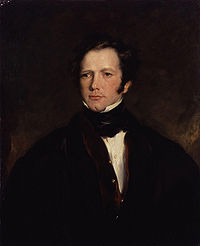Marryat
| Frederick Marryat | |
|---|---|

Portrait by John Simpson, 1826
|
|
| Born |
10 July 1792 Westminster, London, Great Britain |
| Died | 9 August 1848 (aged 56) Langham, Norfolk, United Kingdom |
| Occupation | Royal Navy officer, writer, novelist |
| Nationality | British |
| Period | 19th century |
| Genre | Sea stories and children's literature |
Captain Frederick Marryat (10 July 1792 – 9 August 1848) was a British Royal Navy officer, a novelist, and an acquaintance of Charles Dickens. He is noted today as an early pioneer of the sea story, particularly for his semi-autobiographical novel Mr Midshipman Easy (1836), for his children's novel The Children of the New Forest (1847), and for a widely used system of maritime flag signalling, known as Marryat's Code.
Marryat was born in Great George Street, Westminster, London, the son of Joseph Marryat (1757–1824), a "merchant prince" and member of Parliament, and his American wife Charlotte, née von Geyer. After trying to run away to sea several times, Marryat was permitted to enter the Royal Navy in 1806 as a midshipman on board HMS Imperieuse, a frigate commanded by Lord Cochrane (who later served as inspiration for Marryat as well as other authors).
Marryat's time aboard the Imperieuse included action off the Gironde, the rescue of a fellow midshipman who had fallen overboard, captures of many ships off the Mediterranean coast of Spain, and the capture of the castle of Montgat. The Imperieuse shifted to operations in the Scheldt in 1809, where Marryat contracted malaria; he returned to England on the 74-gun HMS Victorious.
...
Wikipedia
